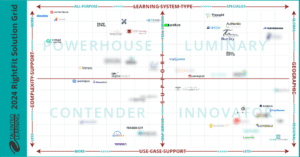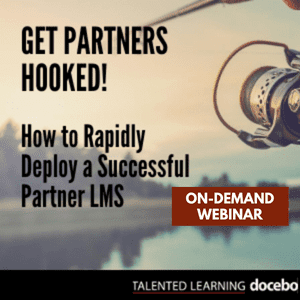
No doubt about it. The pandemic has forced learning professionals everywhere to navigate uncharted waters. And some are paddling much harder than others, just to stay afloat. It’s especially rough for organizations that never offered online learning before, or for those with an “employees-only” mission who must now provide external training, as well.
We saw evidence of the seismic shift in March of 2020, when 63% of our monthly webinar attendees said they were already serving new learning audiences online. Then, at another webinar only one month later, 82% of attendees told us that COVID-19 was accelerating their learning program conversion from in-person training to online delivery.
Although no one could see this tsunami coming, its impact is here to stay. In fact, as a recent McKinsey analysis puts it, digital business has fast-forwarded 10 years in only 90 days! Mind-blowing, but true.
Naturally, it’s been rough for organizations without learning systems that can scale online delivery or accommodate the unique needs of non-employee audiences. I know, because my phone has been ringing off the hook with people who are knee-deep in triage, trying to make it all work.
The New Decision Driver: Opportunity Cost
For numerous organizations, the initial business case has been swift and simple. It’s based on a single imperative:
We can’t afford NOT to deliver external training in this “new normal.”
Many recognize that their industry will never return to business as usual. So moving forward is the only viable alternative if they want to stay competitive.
This makes sense in the heat of a crisis. But if it was your response, you owe yourself a reality check. As soon as you’re able, pause briefly to assess your current learning ecosystem. Is it really designed to achieve your expanded charter? If not, how can you make the case for a stronger solution? Here’s what I recommend…
Which learning system is best for you? Check the 2024 RightFit Solution Grid, based on our team’s independent research! Learn more and get your free copy!
The Business Value of External Training
First, consider the factors that define your various external training audiences. These learners bring diverse interests and goals to the table. Yet all play a vital role in your organization’s success.
 For instance, think of your customers, prospects, channel partners, dealers, suppliers, franchisees, developers, as well as your contract workforce. Every business ecosystem depends on some combination of these constituents. And the more they know about your products and services, the more profitable those relationships are likely to be.
For instance, think of your customers, prospects, channel partners, dealers, suppliers, franchisees, developers, as well as your contract workforce. Every business ecosystem depends on some combination of these constituents. And the more they know about your products and services, the more profitable those relationships are likely to be.
But here’s the catch: You can’t force a customer or partner to participate in your training programs. You can’t insist upon mandatory product education. Unlike employees, external audiences voluntarily choose to participate in educational programs.
This means they need to be enticed to try training, encouraged to continue and acknowledged when they complete it. In other words, audience engagement depends on marketing logic.
For example, the pathway to content must be simple, fast and frictionless. And the learning environment must be as coherent and functionally sophisticated as any popular consumer website or mobile app. (No pressure.)
But with stakes this high, it’s worthwhile to be sure your learning systems actually rise to the extended enterprise challenge. Otherwise, you may lose not only training participants but valued business relationships, as well.
How to Build a Business Case for External Training
Developing a business case doesn’t need to be a scary, over-architected process. It’s just a way of mapping your purchasing rationale in a language that senior decision-makers prefer. Ultimately, you need to answer three key questions:
- What are the reasons for this investment?
- What are the estimated costs?
- What measurable benefits do you expect, based on immediate and ongoing funding?
Many organizations address these questions with a streamlined document they can revise and expand over time. I recommend 5 key components:
1) Goals and Metrics
What business outcomes are important? Do you want to:
- Ensure business continuity?
- Support expansion?
- Increase revenues or profitability?
- Improve efficiency?
- Reduce costs?
- All of these? Or something else?
Choose objectives that you can measure with relevant data from available business systems. The key to actionable insight in access to both training data and business data.
For example, combining LMS and CRM data can be very useful. Many organizations use Salesforce or HubSpot to track direct and channel sales activities, as well as customer purchases across product lines. Comparing this data with training completions can help you calculate ROI and other performance metrics.
2) Audience Analysis
Develop representative profiles for each of the external audiences you want to serve. Consider factors that will influence your learning platform requirements. For example:
- What are their educational needs?
- Why is this important to your organization?
- How will training benefit audience members, as well as your organization?
- How should your learning platform help them achieve their objectives?
In addition, consider the “marketing” aspects of external training:
- How will you attract new learners?
- How will they discover educational content and gain access to the system?
- How will they engage with content – when, why and from what devices?
- How will participants interact with the system over time?
This analysis can be based solely on assumptions. However, it’s smart to validate these assumptions with survey data from target audience members, primary user research or both.
Find out how real-world companies are achieving more with learning systems that create business value. Get inspiration from dozens of success stories in our free LMS Case Study Directory…
3) Content Analysis
No organization wants to develop content if it won’t be used. So be sure to identify the kind of content that will resonate with your audience. For instance:
- What training modes do they prefer? Online courses? Live instructor-led training? Mobile video clips?
- Does this content already exist? Do you need to create it? Is it available through a third-party source?
Also, how will you prioritize, schedule and roll-out content for your LMS launch? And how will you build and manage content over time?
Most organizations use some blend of the following content types for online external training:
- Existing Documents: Educational and business materials that are easy to edit, upload and include in courses, catalogs, curriculums and learning paths
- Online Learning or eLearning: Self-paced instructional content that can be as simple as a PowerPoint deck or as highly evolved as a training simulation
- Social Learning: The ability for learners to enhance their experience through interaction with peers, instructors, subject matter experts, administrators or even broader social media communities
- Video: On-demand or live-stream video clips used as standalone training assets
- Virtual Live Learning: The ability to deliver live online training with virtual classroom tools such as Skype or Zoom
- Virtual Reality: Real-life or animation-based scenario training for physicians, pilots, firefighters, technicians and others in high-consequence occupations.
4) Packaging and Pricing
Will you charge for external training? If so, what price points and bundling variations are optimal?
Many businesses offer no-cost external training to drive broader interest in their brand. Others use content and certification sales as a core revenue stream. Alternatively, you may prefer a hybrid approach, where basic education is available at no charge, but advanced training and certification programs are premium options.
The decision should be based on your organization’s unique cost drivers and overall revenue goals.
5) Forecasting
You can’t expect to conduct a realistic LMS price evaluation without developing reasonable usage and business impact predictions. To estimate usage, try answering these questions:
- How large is each target audience?
- How will you reach these audiences and drive interest in your content?
- What’s the expected average timeframe between first “touch” and first LMS “use”?
- Once learners are onboard, how often will they visit or buy content?
- How fast is your audience likely to grow? How large is it expected to be over time?
- Do you anticipate seasonal variations or other usage patterns?
To estimate measurable business impact, determine how these usage predictions will affect your training initiative’s core business metrics in the short, medium and long run.
Conclusion
Do all these questions seem daunting? You may be wondering how you’ll find the time to fill-in the blanks. Or maybe the fear of analysis paralysis leaves you cold. You may even be tempted to avoid a business case, altogether. And that might be okay in today’s “just make it work” climate.
But soon enough, your decision-makers will hold you accountable for knowing how your external training programs are performing. That’s when you’ll want to know how a new learning platform could improve results. And you’ll be glad you started now to document your business realities.
Thanks for reading!
NEW FOR 2024
Which Learning Systems Are Your Best Fit?
Use our FREE RightFit Grid tool to build a shortlist based on our independent research. 50 leading learning systems mapped to common buyer requirements!
LEARN MORE AND GET YOUR FREE COPY…
Need LMS Selection Help?
You are not alone! Check out our LMS Buyer Services or/and fill out the form below to schedule an initial consultation:
Share This Post
Related Posts
The Future of Customer Education: Customer Ed Nugget 16
Customer education is rapidly evolving as organizations embrace new strategies and tech. What does this mean for the future of customer education? See what experts say on this Customer Ed Nuggets episode
Education Strategy Mistakes to Avoid: Customer Ed Nugget 15
What does it take to deliver a successful customer education program? It starts with a solid education strategy. Learn how to avoid common pitfalls on this Customer Ed Nuggets episode
Which LMS is Best for You? New Shortlisting Tool for 2024
How can you find the best learning system for your business? Our LMS shortlisting tool can help. Learn about the 2024 RightFit Solution Grid. Free, reliable guidance based on our independent research
How to Build a Learning-Based Business: Executive Q&A Notes
Building and selling online courses may seem easy, but building a profitable learning-based business is far more complex. Find out what successful leaders say about running this kind of business
The Rewards of Community Building: Customer Ed Nugget 14
What role does community play in your customer relationships? Find out why community building is such a powerful force in customer education on this Customer Ed Nuggets episode
Benefits of Training Content Syndication: Customer Ed Nugget 13
If you educate customers online, why should you consider content syndication? Discover 10 compelling business benefits in this Customer Ed Nuggets episode
Top Marketing Skills to Master: Customer Ed Nugget 12
Successful customer education programs depend on professionals with expertise in multiple disciplines. Which marketing skills lead to the best results?
How to Measure and Improve Partner Training ROI
An educated channel is a successful channel. But how do you know if your educational programs are effective? Learn from an expert how to evaluate partner training ROI
Mistakes in Ongoing Customer Training: Customer Ed Nugget 11
Customer education doesn't stop with onboarding. It pays to invest in ongoing customer training. Learn which mistakes to avoid in this Customer Ed Nuggets episode















FOLLOW US ON SOCIAL